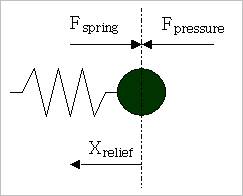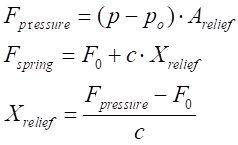
In order to calculate the oil flow through the relief valve, the static method is used in HAT Type B. The relief ball has no mass and no geometry, and the displacement of relief ball is defined as the next static equations. The oil flow through the relief valve can be calculated by the displacement of relief ball.


where,
• is the supply pressure
is the supply pressure
• is the chamber pressure.
is the chamber pressure.
• is the ball section area.
is the ball section area.
• is preload of relief
spring.
is preload of relief
spring.
• is stiffness coefficient of
relief spring.
is stiffness coefficient of
relief spring.
• is displacement of relief ball and is
limited between zero and maximum displacement of relief ball.
is displacement of relief ball and is
limited between zero and maximum displacement of relief ball.
According as the relief ball moves to the calculated displacement by the upper equation, the relief valve opens or closes, and the oil flows. When the relief valve opens, the oil flow through the relief valve is shown in Figure 1.

Figure 1 The oil flow rate through relief valve
As the resistance of the oil through the relief valve depends on the orifice area, in this investigation, the dynamic resistance is considered for the turbulent flow of the oil flow through the relief valve, which yields,

where,
• is the supply pressure
is the supply pressure
• is the chamber pressure.
is the chamber pressure.
(If  is less than
is less than  , there is no oil flow through relief
valve.)
, there is no oil flow through relief
valve.)
• is discharge coefficient of
relief valve
is discharge coefficient of
relief valve
• is the flow area of relief
valve
is the flow area of relief
valve
• is the density of oil
is the density of oil
 represents the oil stream
flowing rate through the opened relief valve into the pressure chamber. The flow
area of relief valve is obtained such as
represents the oil stream
flowing rate through the opened relief valve into the pressure chamber. The flow
area of relief valve is obtained such as

where,  is
is  .
.